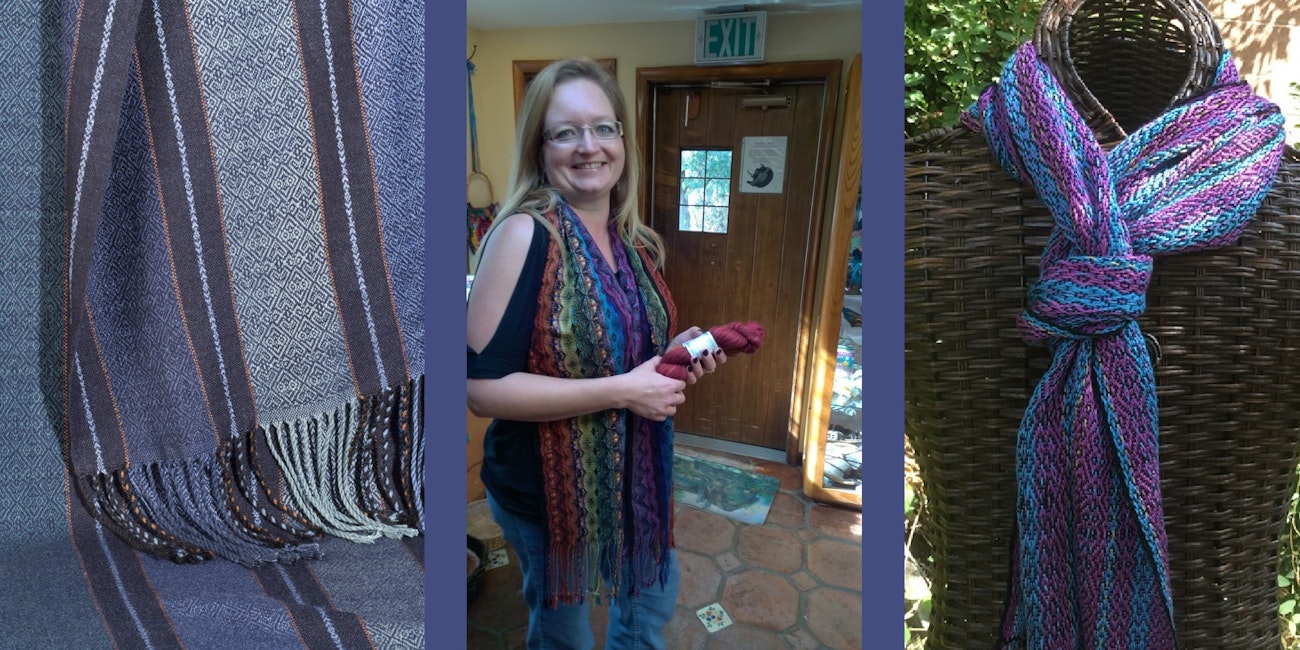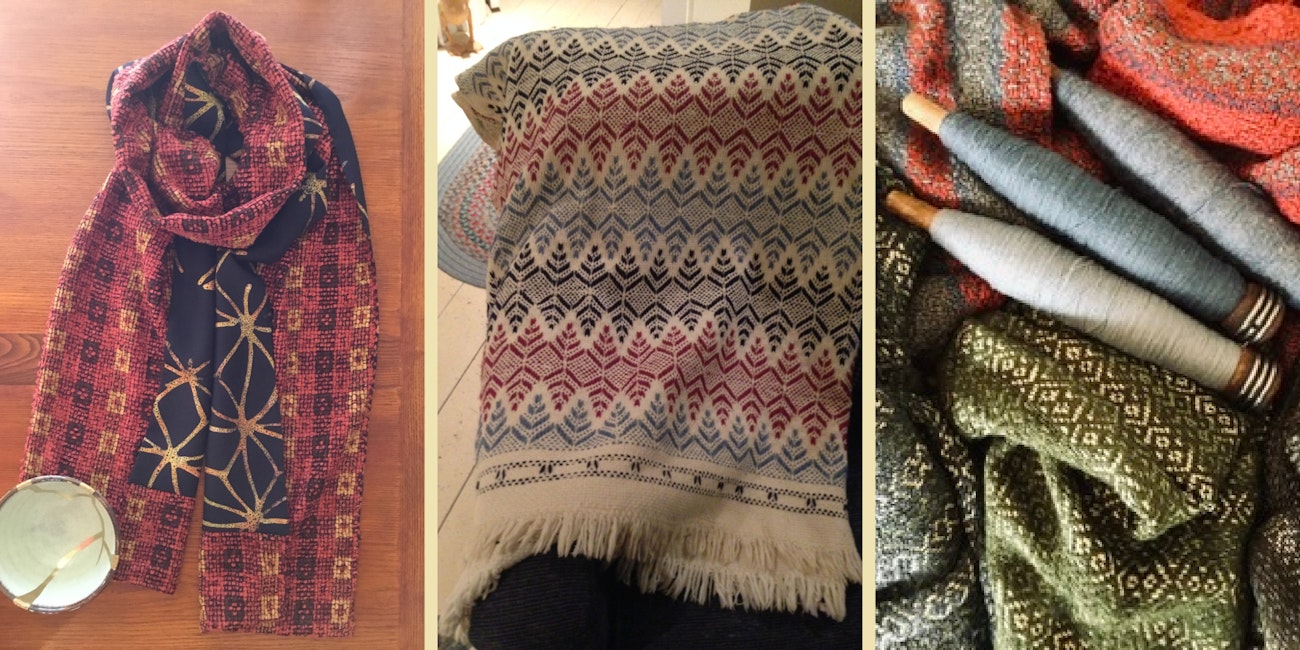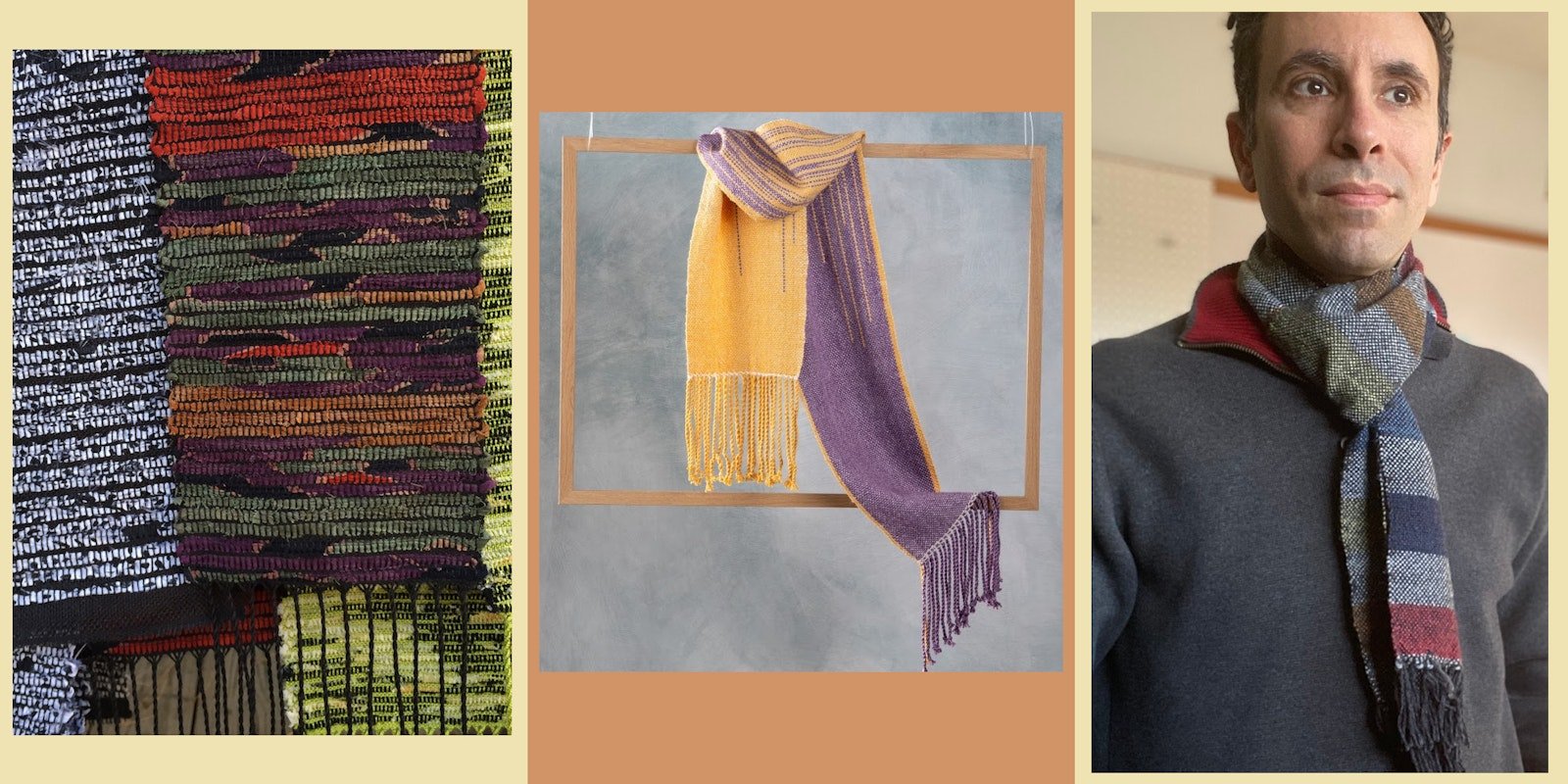For this, the second to last edition of the Reader’s Gallery, I concentrated on scarves and shawls woven on multishaft and rigid-heddle looms. The scope of variety, of not only the messages but also the weaving, amazed me. I would happily add any of these scarves and shawls to my own wardrobe. The next Reader’s Gallery post will be all about pin looms. Hang tight! —Susan
Designer Statements
JoEl Levy Loguidice: I am huge fan of recycling and repurposing. I wove this series of scarves using rag weft from my worn-out silk skirts. The scarves hold lots of good memories.
Anne Merrow: Celebrating the 19th Amendment in a scarf! The gold, purple, and white color scheme was a challenge; mixing purple and gold can lead to mud. Using the clasped-warp technique kept the two colors separate enough to stand on their own, and the thin white weft disappears in the closely sett warp. I used wool from Wyoming, the first state to allow women to vote (in 1869!).
Adam Lazar: I wove this scarf on a rigid-heddle loom with self-striping yarn. Creating something doesn’t need to be complicated. The act of creation is so powerful to our self esteem that making it easy should be a priority. I set up my loom in an area where I could leave it all the time so that on the days I had only five minutes to weave, I could make progress. A couple of picks each day, and the scarf was done.

From the left, Bridget Kraft’s, Joy, Carrie Edwards’s Syracuse University, and Susie Liles’s Shawl for a New Friend. Photos by Sara Kuessner, Carrie Edwards, and Rob Mertz
Designer Statements
Bridget Kraft: The idea of repetition and color can bring about joy even during the most monotonous of times.
Carrie Edwards: Woven in blue and orange, this scarf speaks to where I first learned to weave: my alma mater, Syracuse University, whose colors are blue and orange. It was also my first Etsy sale, so it’s a significant piece to me in a couple of ways.
Suzie Liles: Last November I was fortunate to take a textile tour of Egypt. We had two wonderful tours guides, one of whom I became friends with. I am taking another trip to Egypt in a few weeks to see some of the places again, see some additional places, and soak up the culture with my friend as my tour guide. I decided to make a shawl for my new friend’s mother. The shawl is 33" by 79" long. I used a black wool/silk blend that shows off the Swedish Snowflake advancing twill.

From the left, Susie Hodges’s Ode to the Andes, Katrina King’s Birthday Scarf, and Sam Kievit’s Asymmetrical Challenge. Photos by Sibilia Savage, Shirley Ellsworth, and Sam Kievit
Designer Statements
Susie Hodges: This shawl is one of a series based on traditional Andean weaving-design motifs woven on a modern loom in fancy twill and plain weave stripes. Andean weaving continues to be one of the greatest of world weaving traditions.
Katrina King: An article in Handwoven by Bonnie Tarses inspired me. I reached out to her and got my horoscope charted in the colors in the warp from her. I wear it every year for my birthday, and it always gets rave reviews.
Sam Kievit: This scarf was my answer to combining a weave-along scarf (Tien Chiu and Janet Dawson’s) with my guild’s “Weavers Poker Challenge.” For the challenge, I drew Weave structure: twill; Fiber: Alternative materials; Colors: primary; and Design: asymmetric. I thought I leaned toward asymmetry, but needing to do it within these parameters was an interesting experience!

From the left, Phyllis Miller’s Kintsugi scarf, Barbara Semple’s Warmth and Coziness, and Betsy Chatton’s Heart and Home. Photos by the designers
Designer Statements
Phyllis Miller: Kintsugi is a Japanese method of mending broken ceramics that beautifully accentuates the break. The philosophy is that one unfortunate experience should not ruin an otherwise good thing. Instead, the break can be used to embellish the life of the object. Inspired by a couple of kintsugi bowls, I went through my stash of kimono fabric from discarded and disassembled garments and found some that could be embellished with handwoven fabric and given new life. I used chenille, cotton, and silk in a DPW draft from A Weaver’s Book of 8-Shaft Patterns.
Barbara Semple: This pattern is an example of Swedish hocking, huck embroidery.
Betsy Chatton: Thinking of my mother, whose initials were MV, to give me strength, I’ve been weaving all year in a simple MV twill. MV also represents my home, Mill Valley, so my scarves are filled with heart and home.

